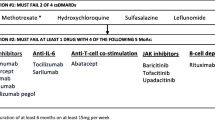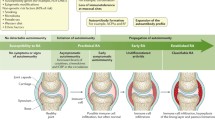Abstract
A large base of evidence exists regarding treatments for rheumatoid arthritis (RA) and how they may be used to preserve long-term function and improve patient outcomes. However, little is known about whether real-life rheumatology practice reflects the evidence base. This survey aimed to capture differing perceptions among rheumatologists in the identification and treatment of patients and to understand how their management of and treatment decisions for patients with RA may be influenced by the current published literature. Rheumatologists from five European countries and Canada participated in a survey between April and May 2006 to establish how rheumatologists identify and treat particular patient types in everyday practice. In total, 458 rheumatologists responded to the online and telephone survey. Rapidly progressing disease was overwhelmingly recognized (97%) as a distinct subtype among patients with RA, and the majority (88%) of respondents make treatment decisions based on this distinction. Most rheumatologists use measures including C-reactive protein, erythrocyte sedimentation rate, tender/swollen joint counts, and X-ray progression to diagnose and monitor this particular group of patients; a minority (30%) used magnetic resonance imaging to identify and monitor patients with rapidly progressing disease. Although treatment goals for these patients were similar among rheumatologists, the treatment approach varied considerably across countries. Overall, rheumatologists agree on the management goals for patients with rapidly progressing RA; however, their treatment patterns have some dissimilarities.






Similar content being viewed by others
References
Feldmann M, Brennan FM, Maini RN (1996) Rheumatoid Arthritis. Cell 85:307–310
Boers M, Kostense PJ, Verhoeven AC, COBRA Trial Group et al (2001) Inflammation and damage in an individual joint predict further damage in that joint in patients with early rheumatoid arthritis. Arthritis Rheum 44:2242–2246
Scott DL, Symmons DP, Coulton BL et al (1987) Long-term outcome of treating rheumatoid arthritis: results after 20 years. Lancet 1:1108–1111
Eberhardt KB, Truedsson L, Pettersson H et al (1990) Disease activity and joint damage progression in early rheumatoid arthritis: relation to IgG, IgA, and IgM rheumatoid factor. Ann Rheum Dis 49:906–909
Paimela L, Palosuo T, Leirisalo-Repo M et al (1995) Prognostic value of quantitative measurement of rheumatoid factor in early rheumatoid arthritis. Br J Rheumatol 34:1146–1150
Sattar N, McCarey DW, Capell H et al (2003) Explaining how “high-grade” systemic inflammation accelerates vascular risk in rheumatoid arthritis. Circulation 108:2957–2963
Drossaers-Bakker KW, de Buck M, van Zeben D et al (1999) Long-term course and outcome of functional capacity in rheumatoid arthritis: the effect of disease activity and radiologic damage over time. Arthritis Rheum 42:1854–1860
Welsing PM, van Gestel AM, Swinkels HL et al (2001) The relationship between disease activity, joint destruction, and functional capacity over the course of rheumatoid arthritis. Arthritis Rheum 44:2009–2017
Wolfe F, Hawley DJ (1998) The longterm outcomes of rheumatoid arthritis: work disability: a prospective 18 year study of 823 patients. J Rheumatol 25:2108–2117
Buckley CD (1997) Science, medicine, and the future: treatment of rheumatoid arthritis. BMJ 315:236–238
Harris ED Jr (1990) Rheumatoid arthritis: pathophysiology and implications for therapy. N Engl J Med 322:1277–1289
Doyle JJ, Eliasson AH, Argyros GJ et al (2000) Prevalence of pulmonary disorders in patients with newly diagnosed rheumatoid arthritis. Clin Rheumatol 19:217–221
Cojocaru VM, Ciurtin C, Pop M et al (2006) Ophthalmological involvement in rheumatic disease. Oftalmologia 50:56–61
Pincus T, Callahan LF (1986) Taking mortality in rheumatoid arthritis seriously: predictive markers, socioeconomic status and comorbidity. J Rheumatol 13:841–845
Williams EA, Fye KH (2003) Rheumatoid arthritis: targeted interventions can minimize joint destruction. Postgrad Med 114:19–28
Goekoop-Ruiterman YPM, de Vries-Bouwstra JK, Allaart CF et al (2005) Clinical and radiographic outcomes of four different treatment strategies in patients with early rheumatoid arthritis (the BeSt Study): a randomized, controlled trial. Arthritis Rheum 52:3381–3390
Quinn MA, Conaghan PG, O’Connor PJ et al (2005) Very early treatment with infliximab in addition to methotrexate in early, poor-prognosis rheumatoid arthritis reduces magnetic resonance imaging evidence of synovitis and damage, with sustained benefit after infliximab withdrawal: results from a twelve-month randomized, double-blind, placebo-controlled trial. Arthritis Rheum 52:27–35
Smolen JS, van der Heijde D, St Clair EW, Active-Controlled Study of Patients Receiving Infliximab for the Treatment of Rheumatoid Arthritis of Early Onset (ASPIRE) Study Group et al (2006) Predictors of joint damage in patients with early rheumatoid arthritis treated with high-dose methotrexate with or without concomitant infliximab: results from the ASPIRE Trial. Arthritis Rheum 54:702–710
Breedveld FC, Weisman MH, Kavanaugh AF et al (2006) The PREMIER study; a multicenter, randomized, double-blind clinical trial of combination therapy with adalimumab plus methotrexate versus methotrexate alone or adalimumab alone in patients with early, aggressive rheumatoid arthritis who had not had previous methotrexate treatment. Arthritis Rheum 54:26–37
Klareskog L, van der Heijde D, de Jager JP et al (2004) Therapeutic effect of the combination of etanercept and methotrexate compared with each treatment alone in patients with rheumatoid arthritis: double-blind randomised controlled trial. Lancet 363:675–681
St. Clair EW, van der Heijde DM, Smolen JS et al (2004) Combination of infliximab and methotrexate therapy for early rheumatoid arthritis: a randomized, controlled trial. Arthritis Rheum 50:3432–3443
Galindo-Rodriguez G, Aviña-Zubieta JA, Russell AS et al (1999) Disappointing long-term results with disease modifying antirheumatic drugs. A practice based study. J Rheumatol 26:2337–2343
Lipsky PE, van der Heijde DMFM, St. Clair EW et al (2000) Infliximab and methotrexate in the treatment of rheumatoid arthritis. Anti-Tumor Necrosis Factor Trial in Rheumatoid Arthritis with Concomitant Therapy Study Group. N Engl J Med 343:1594–1602
Fleischmann RM (2005) Is there a need for new therapies for rheumatoid arthritis? J Rheumatology 32(suppl 73):3–7
Grigor C, Capell H, Stirling A et al (2004) Effect of a treatment strategy of tight control for rheumatoid arthritis (the TICORA study): a single-blind randomised controlled trial. Lancet 364:263–269
Allaart CF, Goekoop-Ruiterman YP, de Vries-Bouwstra JK, FARR study group et al (2006) Aiming at low disease activity in rheumatoid arthritis with initial combination therapy or initial monotherapy strategies: the BeSt study. Clin Exp Rheumatol 24(6[suppl 43]):S77–S82
Van der Kooij SM, Van der Bijl AE, Allaart CF et al (2007) Remission induction in early rheumatoid arthritis with initial infliximab and methotrexate therapy: 4-year follow-up data of the disease course after infliximab discontinuation in the BeSt trial. Ann Rheum Dis 66(suppl II)):192
Acknowledgement
The survey was executed, and responses were analyzed by Harris Interactive, an international market research company.
Funding
Financial support for this study was provided by Schering-Plough Corporation.
Disclosure
Prof. McInnes has received grant funding and honoraria from Schering-Plough, Wyeth, Abbott, and Roche, all of whom manufacture/sell biologic agents.
Author information
Authors and Affiliations
Corresponding author
Rights and permissions
About this article
Cite this article
McInnes, I. Does practice mirror the evidence base in the treatment of rheumatoid arthritis?. Clin Rheumatol 28, 961–970 (2009). https://doi.org/10.1007/s10067-009-1189-9
Received:
Revised:
Accepted:
Published:
Issue Date:
DOI: https://doi.org/10.1007/s10067-009-1189-9




